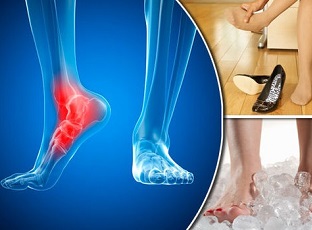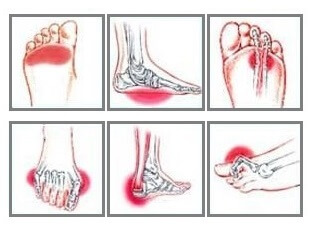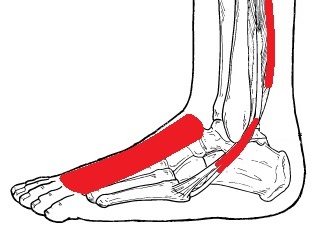- Home
- Common Foot Problems
- Plantar Fibromatosis
- Treatment
Treatment For Plantar Fibroma
Written By: Chloe Wilson BSc(Hons) Physiotherapy
Reviewed By: FPE Medical Review Board
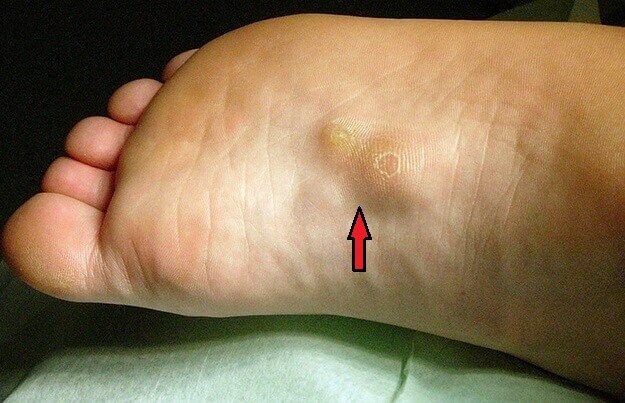
Treatment for plantar fibroma foot pain varies from exercises to injections, radiotherapy to surgery.
A plantar fibroma is a small lump that forms in the sole of the foot.
Often painless, the a fibroma nodule may go unnoticed for years, but if it is causing problems then there are lots of treatments that can help.
A plantar fibroma, also known as Ledderhose Disease or Plantar Fibromatosis, is a fairly rare cause of foot pain and there are lots of things that can help reduce symptoms and recurrence.
Treatment for plantar fibroma aims to reduce the pressure through the nodule and reduce the size of the lump to help reduce pain and allow normal function.
Here we will look at the common causes of plantar fascial fibromatosis and the different options for treatment for plantar fibroma.
What Is A Plantar Fibroma?
A plantar fibroma is a small nodule of fibrous tissue that develops in the ball of the foot that may or may not cause foot arch pain.
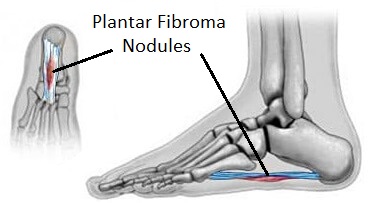
The bottom of the foot is supported by a thick, strong ligament-type band called the plantar fascia that runs from the heel to the toes, helping to form the normal arch shape of the foot.
If the plantar fascia is damaged, over-stretched or repetitively overloaded, then thickenings may develop, forming small nodules known as plantar fibromas. This leads to a firm lump underneath the foot.
When one or more of these nodules develop, it is known as "Plantar Fibromatosis", aka or "Plantarfascial Fibromatosis" or "Ledderhose Disease" after the German doctor Georg Ledderhose who first described the condition in 1894.
Typical symptoms of Plantar Fibromas include:
- Small Nodule: A small lump like a pea can be seen and/or felt underneath the foot
- Foot Arch Pain: Typically when pressure is applied to the nodule or when standing or walking. A plantar fibroma may be entirely painless for years
- Foot & Toe Stiffness: which can make walking difficult
Find out more about the causes, symptoms & diagnosis: Plantar Fibromatosis.
Top Treatment For Plantar Fibroma
There are three stages of treatment for plantar fibroma foot pain:
- Observation: If the plantar fibroma is not causing any pain or limiting daily activities then in most cases active treatment for plantar fibroma is not necessary and your doctor will just keep an eye on it
- Non-Surgical Treatment: If your plantar fibroma is causing mild to moderate pain, then there are a number of treatments that can help such as exercises, injections and shoe orthotics
- Surgical Treatment For Plantar Fibroma: If your plantar fibroma is causing considerable pain and has failed to respond to non-surgical treatment then surgery may be advised.
Let's start by looking at the non-surgical options for treatment for plantar fibroma and then we'll look at the surgical options.
#CommissionEarned from Amazon on qualifying purchases
1. Plantar Fibroma Injections
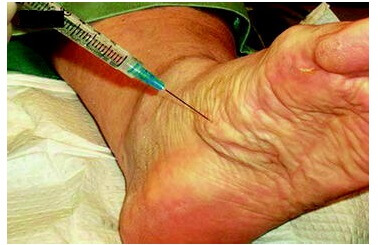
One of the most common treatments for plantar fibroma is a corticosteroid injection into the foot.
This is where a mixture of steroid and local anaesthetic is injected directly into the plantar fibroma nodule to reduce pain and inflammation and can help to reduce the size of the nodule.
The effects of corticosteroid injection treatment for plantar fibroma are usually felt pretty instantly with an immediate reduction in pain and the size of the nodule should gradually decrease over the next few days.
Injections tend to be most effective in the early stages of plantarfascial fibromatosis so should definitely be considered as part of your treatment for plantar fibroma. However, it is important to be aware that in some cases, the effects of the injection wear off quite quickly so injections should be used alongside other treatments for plantar fibroma.
Ideally, corticosteroid injections should be carried out under ultrasound guidance to ensure that the corticosteroid mix is precisely delivered to the right spot, so should only be carried out by a trained professional.
2. Plantar Fibromatosis Exercises
The most effective plantar fibromatosis exercises focus on stretching and strengthening the plantarfascia as well as the surrounding soft tissues such as the calf muscles and achilles tendon.
Stretches and strengthening exercises can both really help to reduce the tension through the plantar fascia which leads reduces the irritation through the plantar fibroma making them an effective treatment for plantar fibroma.
- Stretches: There are various different ways to stretch the plantar fascia which can really help as part of your treatment for plantar fibroma such as using golf balls or chilled drinks cans. LEARN MORE: Plantar Fascia Stretches
- Strengthening Exercises: Strengthening the muscles that support the foot arch again really helps to reduce the tension through the plantar fascia and the pressure on a plantar fibroma. LEARN MORE: Plantar Fascia Strengthening Exs
Plantar fibromatosis exercises are important not only as part of treatment for plantar fibroma, they also help to prevent nodules forming in the first place making them a great preventative tool.
3. Plantar Fibroma Orthotics
Another really useful tool for treatment for plantar fibromatosis is orthotics, special inserts that you wear in your shoe. Orthotics help to reduce the pressure on plantar fibroma nodules so really come into their own with larger nodules that are painful to touch.
The most common type of orthotics used for treating plantar fibromatosis foot pain are arch supports which help support the foot in the correct position and take tension off the plantar fascia. These are great in the early stages of treatment for plantar fibroma, but once the nodule gets to a certain size, they can actually be counterproductive as they can actually place more pressure through the fibroma due to their close fit.
If this is the case, then you want to talk to an orthotist or podiatrist. They will be able to provide custom orthotics that are shaped for your own foot accounting for the position and size of your plantar fibroma nodules.
It is not as easy as simple cutting a bit out of an arch support to reduce the pressure on the nodule so don't try this one at home! A professional will be able to provide orthotics that give the correct amount of support both under the arch and at the heel, as well shaving or grinding a pocket out for the plantar fibroma.
Whilst orthotics won't directly cure plantarfascial fibromatosis, they are a really effective way of reducing the pain, making them an important part of treatment for plantar fibroma so that you can do your usual daily activities.
4. Ice Therapy
Regularly applying ice to the foot arch can really help to reduce pain and swelling from a plantar fibroma. You can either use a simple ice pack, or you can get specially designed foot wraps. These are perfect because you strap them around the mid foot so they stay in place well, even when you move around and you target the right area without chilling the entire foot!
5. Physical Therapy
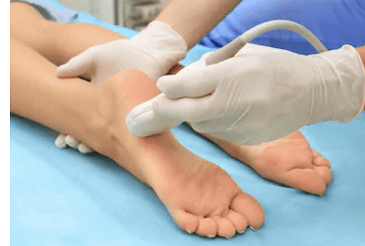
Physical therapy treatment for plantar fibroma will often include ultrasound or shockwave therapy. These help to break down adhesions and can reduce the size of plantar fibroma nodules.
It often takes 3-4 sessions of ultrasound or shockwave therapy to notice a difference in pain levels or the size of the fibroma.
Your physical therapist can also assess your foot biomechanics and muscle strength and length to provide you with a tailored treatment programme for your plantar fibromatosis.
6. Radiotherapy
Radiotherapy can be a really helpful treatment for plantar fibroma. If the nodule is growing and active then radiotherapy has been shown to prevent further progression of Ledderhose Disease in approximately 80% of people*.
As well as stabilizing the condition, radiotherapy can also shrink and soften the fibroma, thus reducing pain. Some people are nervous about undergoing radiation, but studies have shown that patients undergoing radiation as part of their treatment for plantar fibroma report minimal toxicity and high rates of satisfaction*.
Radiotherapy has been shown to be much more effective than surgery in the treatment of plantar fibroma and is much less invasive.
7. Surgery For Plantar Fibromatosis
Plantar fibromatosis surgery is usually the last option with treatment for plantar fibroma and shouldn't be considered unless plantar fibromatosis symptoms are severe and all other treatment options have failed.
This is because as well as surgery being invasive, there is a high risk of recurrence of the plantar fibroma (up to 50%*), injury to surrounding structures in the foot, scar tissue formation, loss of the normal foot arches and the development of hammertoe.
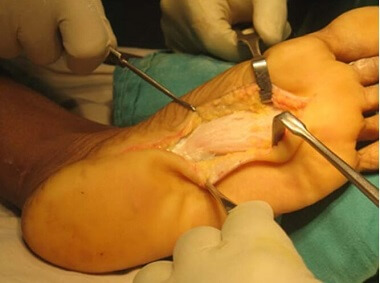
Plantar fibromatosis surgery is typically performed under local anesthetic rather than a general, and is usually done as a day case.
The nodule is excised (removed) along with a surrounding section of the plantar fascia as this helps reduce the risk of recurrence.
Following ledderhose surgery it is advisable to keep the foot elevated on a leg cushion whenever possible to reduce swelling and you will need to use crutches for 2-3 weeks to keep any weight off your foot as it heals. Check out these top tips on getting up and down stairs with crutches!
Applying ice regularly can also help to reduce pain and swelling - either use a regular ice pack or you can get specially designed foot wraps that wrap around the midfoot section so you don't have to chill the whole foot!
People can usual return to work around 3-6 weeks after Ledderhose surgery and restart sports after around 3 months*. It may take 3-8 weeks for the swelling to subside enough to wear normal shoes.
Plantar Fibroma Recovery
It typically takes about 6 to 12 months for plantar fibromas to heal completely. However, it may take longer depending on the severity of your condition and how aggressively you manage it with treatment for plantar fibroma.
During recovery from plantar fibromatosis, you may need to modify activities that place stress on your foot, such as running or walking. You should also avoid going barefoot as much as possible, since it can increase the risk of further injury. It is important to maintain a healthy lifestyle by eating a balanced diet and exercising regularly, as this can help speed up the healing process. Additionally, it is important to regularly stretch your feet and calf muscles to prevent stiffness in the area.
With the correct treatment for plantar fibroma, you can expect to make a full recovery.
Differential Diagnosis
Plantar fibromas are just one possible cause of lumps and bumps on the bottom of the foot. There are a number of other conditions that can cause foot arch lumps such as:
- Bone Spurs: where there is excess bone growth
- Mortons Neuroma: where a lump forms on one of the foot nerves
- Plantar Warts: benign epithelial tumours
- Cysts: small pockets of fluid
You can find out more about each of these in the bump on bottom of foot article
What Else Can Help?
Plantar fibroma is a rare cause of foot pain and is often confused with plantar fasciitis where there is damage to the plantar fascia itself. Plantar fasciitis is caused by inflammation of the plantar fascia, while plantar fibroma is caused by excessive connective tissue growth within the plantar fascia. If there is no visible or palpable lump, it is more likely to be plantar fasciitis than plantar fibroma.
Plantar fascial fibromatosis is only one possible cause of pain underneath the foot. If plantar fibromatosis isn’t sounding quite like your problem, visit the foot arch pain page in the diagnosis section for help working out what may be causing your problem.
You may also be interested in the following articles:
- Pain On Top Of Foot
- Side Foot Pain
- Nerve Pain In The Foot
- Foot & Ankle Stretches
- Swollen Feet & Ankles
- Foot Numbness
- Foot Lumps
If you want to know more about treatment for plantar fibroma, talk to your doctor, podiatrist or physical therapist.
Related Articles
References
- Podiatry Today: How To Modify Orthoses For Plantar Fibromatosis. L. Huppin DPM, February 16, 2015
- International Journal of Radiation Oncology: Radiotherapy is effective in the treatment of progressive plantar fibromatosis (morbus ledderhose). M. Attassi & H.M. Seegenschmeidt, November 2001
- Practical Radiation Oncology Journal: Patient-reported outcomes after electron radiation treatment for early-stage palmar and plantar fibromatosis. J. Schuster, S. Saraiya, N. Tennyson, M. Nedelka, N. Mukhopadhyay & E. Weiss. July 2015
- Wye Valley NHS Trust: Plantar Fibroma Excision. Patient Information Sheet
Page Last Updated: 5th February, 2025
Next Review Due: 5th February, 2027
